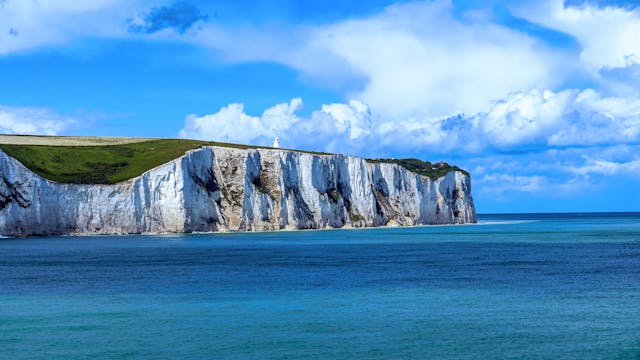
Why are the White Cliffs of Dover white? The White Cliffs of Dover are white because they are made of white chalk, which is a type of limestone.
The White Cliffs of Dover are a very famous symbol of the UK. During the Second World War they were often sung about because when pilots crossed over them, or when sailors or soldiers on ships saw them, they knew that they were safe. You can see the White Cliffs from France when the weather is good and the sight could have made British people fighting in France long to be home. The cliffs stretch for 13 km with the town of Dover in the middle of them, hence their name as the White Cliffs of Dover. They are 110 m tall at their highest point. There is no way of knowing when the cliffs were first named, but they and the town of Dover have existed for a very long time. Archaeological digs in and around Dover show that people have lived there since the Stone Age and there was an Iron Age settlement. Julius Caesar tried to land at Dover, but the white cliffs were too easily defended and he sailed on. The Romans, and numerous people since, then used the cliffs themselves for defense. Dover became a very important port and the Dover Calais ferry route is probably the most used route between the UK and mainland Europe. It is 42.4 km and 1,831 people have actually swum across. The first person was Matthew Webb in 1875.
So, why are the cliffs white? Well, they are not pure white. They have streaks of black flint, but they are white enough to be seen from a long way away. They get their color from chalk, which is a type of limestone and is actually made deep under the sea. The chalk that the White Cliffs are made of was formed between 100 and 66 million years ago during a period called the Late Cretaceous. Chalk is a sedimentary rock, which means it is made from accumulated sediment pressed together under high pressure. The chalk that became the White Cliffs was made from the shells of a microscopic algae called coccolithophore. These algae were single celled organisms, but they produced a series of tiny plates made of calcium carbonate to cover and protect themselves. Each plate was only about 2 to 25 micrometers, which is tiny. A human hair is between 17 and 180 micrometers across, to give you an idea of scale. When the algae died, they sank to the bottom of the sea with their calcium plates. The algae biodegraded, but the calcium plates didn’t and they started to build up. Because they are miniscule and because the sea is so large, they didn’t build up very quickly. Estimates are that they built up about 1 mm every two years. That isn’t a lot, but over time it starts to add up. 1 m every 20,000 years. Over 34 million years, the sediment built up and as it did, the weight from the sediment on top became immense and it crushed the underlying sediment down. The pressure shaped the sediment into chalk. And this is the chalk that formed the White Cliffs of Dover.
So, how is chalk formed under the sea part of the White Cliffs? When the chalk was formed, millions of years ago, Britain and most of Europe was under a deep sea. Then, two things happened. The tectonic plates that carry Africa, India, and Europe collided and several mountain ranges were formed, including the Alps and the Himalayas. This mountain building period pushed the chalk that would form the White Cliffs of Dover up and out of the sea. Then, quite a lot later, there were several ice ages and sea levels dropped, uncovering even more of the cliffs, leaving what we can see today.
The cliffs are very beautiful, but they are made of chalk, which is a very soft rock. Erosion is a big problem with the cliffs. They are eroding at a rate of roughly 2.5 cm a year. The rate used to be slower, but stronger storms have sped up the rate. The cliffs are not going to disappear any time soon because they are quite thick, but the buildings that are on top of them and near to them may have to be moved. Interestingly, there are also a large number of tunnels that were dug into the cliffs. The first ones were dug during the Napoleonic wars to make canon escarpments, and the later tunnels were built during the Second World War. You can visit them. And this is what I learned today.
Photo by Valentin Onu: https://www.pexels.com/photo/white-cliffs-of-dover-27658730/
Sources
https://en.wikipedia.org/wiki/White_Cliffs_of_Dover
https://en.wikipedia.org/wiki/Alpine_orogeny
https://en.wikipedia.org/wiki/Coccolith
https://en.wikipedia.org/wiki/Dover
https://www.dovermuseum.co.uk/Information-Resources/Articles–Factsheets/White-Cliffs-of-Dover.aspx
